I had the fortune of attending The Game Developers Conference 2018 in San Francisco this year.
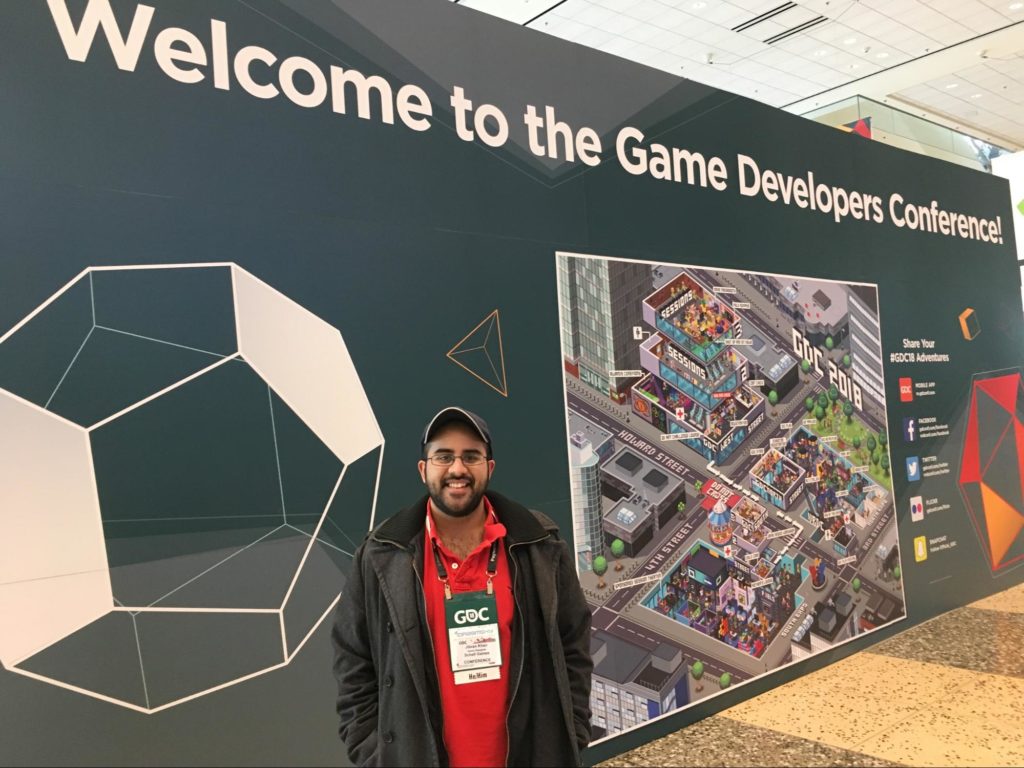
Throughout the conference I took the following notes which I thought to share!
Day 1 – 3/19/2018
My first day at GDC involved visiting a number of sponsored talks as well as a great talk on the game Mortician’s Tale.
Google Dev Day
In this event Google was presenting a number of new features. One in particular was Google Instant. The concept is that developers would create partial builds that would act as a lite version of the experience used to give a demo of the experience. One interesting concept they proposed was that as speed increases, consumption increases.
Amazon – Gameon
This session was a demo for introducing Amazons Gameon feature. In the talk the speaker went through how to implement the Gameon system providing diagrams and code samples.
Gameon, as I understood it, is a service that allows deliveries leveraging the Amazon delivery service. The example the speaker spoke at length about was integrating real world prizes into a game system using Amazon’s delivery service e.g. a player wins a game and a real prize is delivered to them by Amazon.
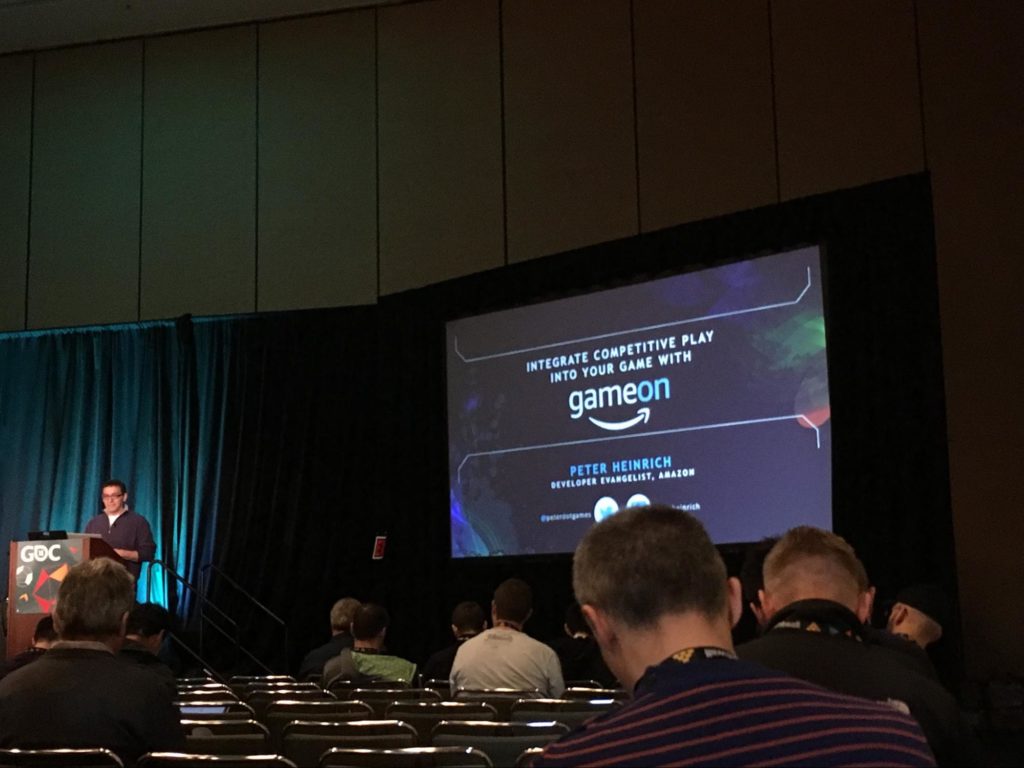
Amazon – Future of E-Sports
In this panel hosted by Amazon the speakers gave their opinion on the future of E-Sports and made a number of interesting points including:
- What was driving the increase in size of esport was not something in mobile applications, but the increase in the number of devices, and increase in speed of infrastructure.
- The best e-sport is easy to pickup but hard to master.
- The perceived skill gap of mobile vs PC is good for the e-sports as its about accessibility having mobile in the e-sports scene.
- When you have a hit one challenge is to sustain the momentum. There are several ways to do so. Two ways are building a brand or building a community.
- Games that are good for broadcasting are surprising, unpredictable, and easy to watch.
- E-Sports has a structure like that of regular sports. Blizzard for example has franchises all over the world, and the owners of E-Sports teams are like the owners of traditional sports teams.
Mortician’s Tale – A Different View on How Games Treat Death
This talk was about the concept of death in a game called Mortician’s Tale. As described by the creator Morticians Tale is ‘a job simulator game’ about being a Mortician.
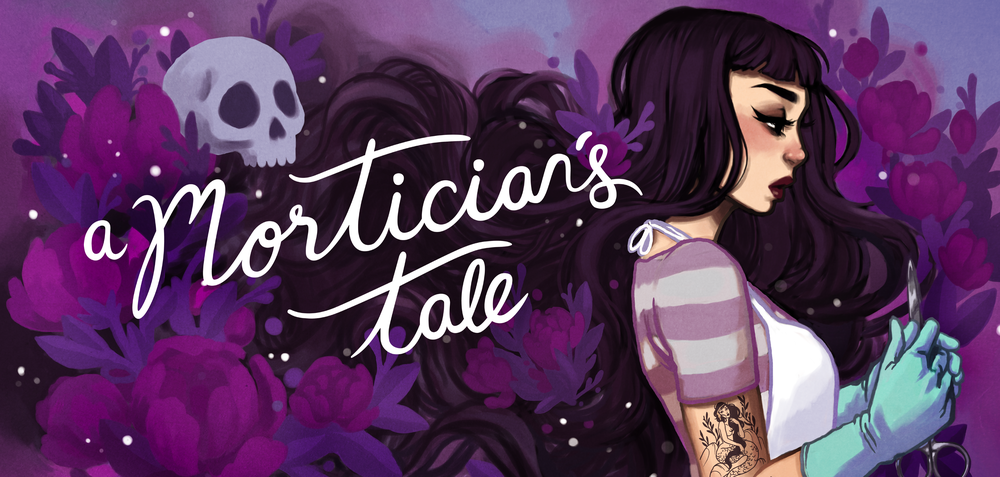
During the talk the speaker made a number of interesting points including:
- Death systems in games have endured. In Mortician’s tale they wanted to explore ways of displaying it.
- It was important that death in the game should relate to narrative and mechanics of game.
- One book that was influential to the development was ‘Smoke Gets in Your Eyes’ by Caitlin Doughty.
- The purple color in the game was used to hide the ugliness of death and reflects melancholy.
- The game removes the ability to fail during preparation of the body as the creators felt it would disrespect the bodies.
- The protagonist of the game was made silent as a silent protagonist can act as a vessel for players.
- A silent protagonist also underscores the importance of listening in the grieving process.
- Post release the feedback was positive and the creator believed there was some evidence of a transformative effect due to the design decisions made while making the game.
At the end of the conference the speaker made recommendations of a number of other games to look at that explore the topic of death:
Finally the speaker made four major recommendations for how to do death in games better:
- Make it meaningful.
- Do your research.
- Be understanding with your players.
- Asses your own feelings.
Day 2 – 3/20/2018
For my second day at GDC I went to a GDC Mobile Summit talk, then two interesting Indie Summit talks.
Building Entertainment Experiences for Emerging Mobile Platforms
Another panel style setting, this time hosted by Zynga, the panel made a number of interesting points including:
- Google Play Instant: Special of accessibility increases mean consumption increases.
- Zynga is looking to tap bigger share of the market through new platforms.
- Combination of strong social elements and game in mobile is maybe a new young design space.
- Features like Google Instant are a double edged sword as players move in faster in and move out faster.
- So when creating games we have to create experiences where you give progress quickly.
- FTUE -> Arcade experience -> Introduce friends
- Synchronous game with friends using social media is not so common, using services like messenger creates new opportunities.
- Google Instant may change the way players compare and consume game media.
- Benefit of being a new platform is you get more exposure.
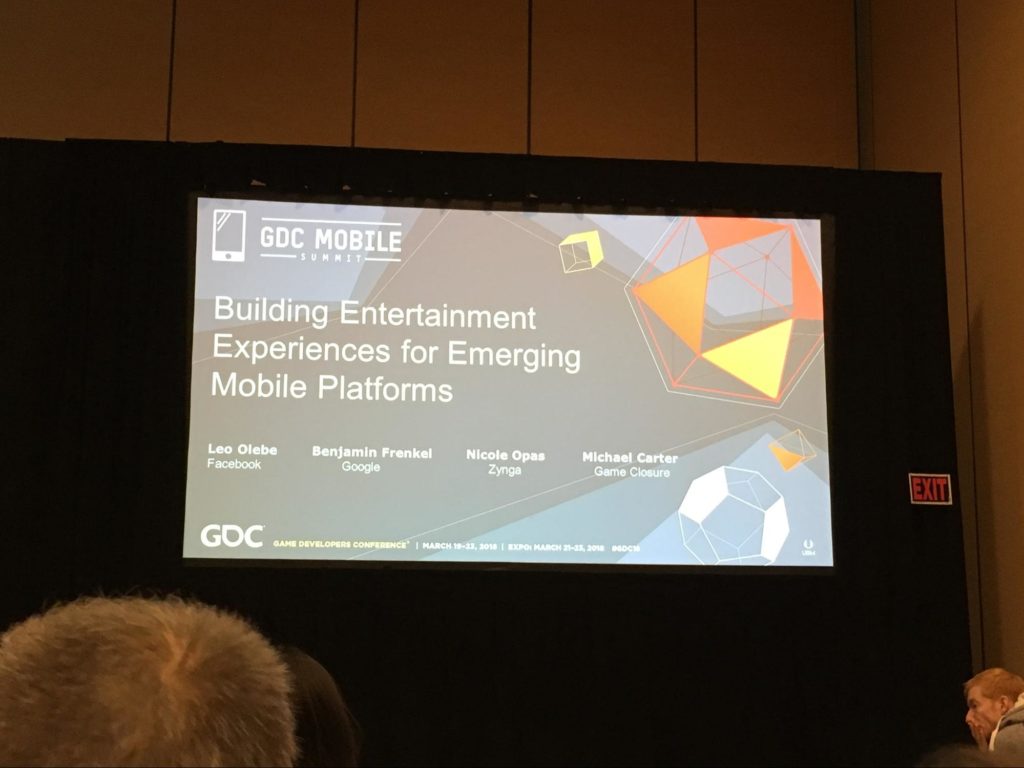
Building Games That Can Be Understood at a Glance
The speaker advocated making a game super easy to understand at a glance (imagine reading it while walking in a subway) using the concept of multiple reads:
- 1st – Biggest draw pulls you in, core of the game.
- 2nd – The Key details – big rules.
- 3rd – Contextual information.
- 4th – Toggled Read using movement and animation.
Results
- Easier take in.
- Improves organic discovery.
- Easier marketing.
After the session I asked the speaker Zach Gage about his ideation process. Zach makes tons of prototypes and tests them. He makes a game in 2 hours (if its feels special then builds it out and playtests it) if it passes the quality bar then he keeps working on it. Like a milestone system.
Foolproofing the Controls for ‘ What Remains of Edith Finch’
In the talk the speaker listed a number of goals for the control system:
- Discoverable.
- Leave player same freedom.
- Minimal attention.
- Feedback directly matches input.
- Look natural.
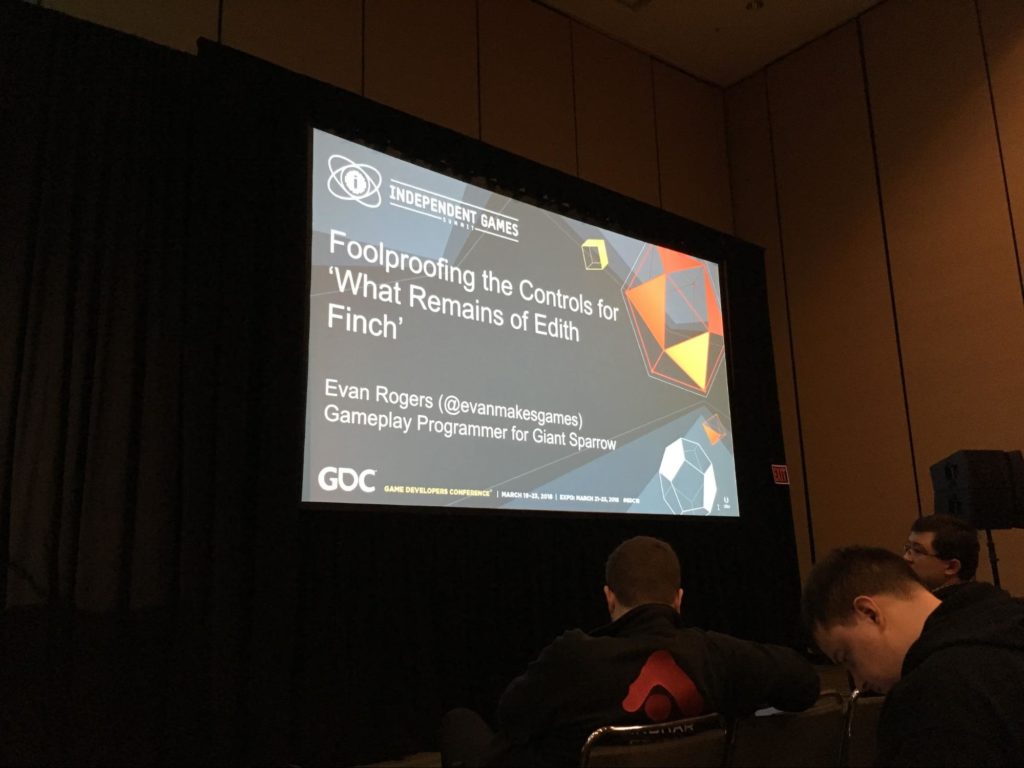
During the talk the speaker gave a number of useful tips during the talk including:
- Avoid distractions e.g. unhelpful inputs, pause narration, actions.
- If players can make progress, any progress with what they know they will really try to do stuff with that method, and may eventually become frustrated if that method doesn’t work.
- Depth is hard to judge with first person needs very generous goals.
Day 3 – 03/21/2018
Day three is when the main conference began. My day was spent visiting a number of talks that were of interest to me.
AAA UI
During the talk the speaker made a number of interesting points including:
- Differentiating between UI and UX.
- UX – End to end experience.
- UI in-game look – Core gameplay, front end.
- The speaker recommended a TED talk, Design for 5 Senses.
- In designing UI it was important that periphery info was on the outer part of the screen, and crucial info in the center of the screen.
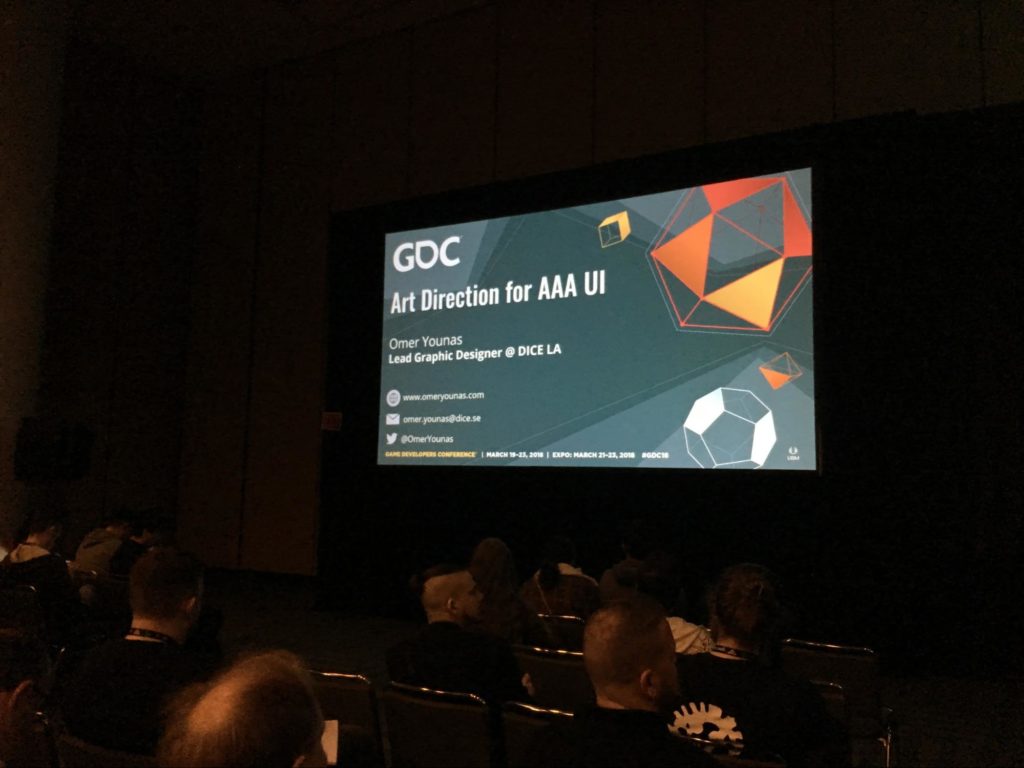
- Our eyes are biologically sensitive to red/green in center of vision.
- Perception sequence Shape -> Color -> Form.
- Gestalt theory is useful.
- Fonts
- Larger use lighter font
- Smaller use heavier font
- Interesting max size string is using the character W repeatedly and catering for this with tests.
- Cultural importance of color look up meaning of color in different cultures.
- Consider changing UI luminosity to make it easier to read on black backgrounds.
- Illustrator is a great tool.
- Research | UI should serve both form + function.
West of Loathing Post Mortem
This post mortem looked at the game West Loathing.
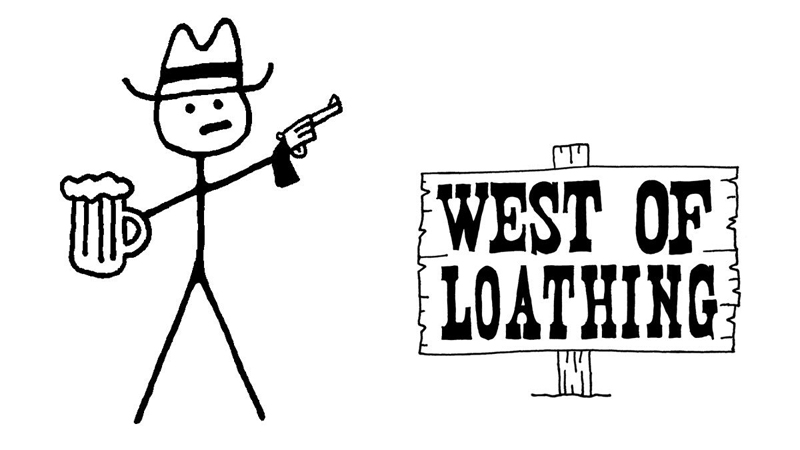
I felt this post mortem to be an honest reflection on the game on what went right and wrong. The speaker made a number of interesting points including:
Pre Production
- 2 years before release the work started | Started with design
- Sketches
- Maps
- Quest line
- World scope
Production
- Fleshing out areas, flesh out interactions.
- Keeping track of progress.
- CPG – Couple of pointless gags.
- Tools -> Able to add content without using Unity (MSQL database) that loads data into client.
What Went Wrong
- Since the world was developed first not story had a bunch of anticlimactic moments.
- Hard to tell when things were done.
- Rough QA at the end.
Nuke Possum Springs: A ‘Night in the Woods’ Design Postmortem
During this talk the speaker made a point which interested me regarding exploration. The creators considered it ok to miss things, as they wanted people to experience the game differently.
Sonic Post Mortem
A talk given by the some of the original creators of Sonic. I enjoyed this talk, listening to the speakers was magical. They made several interesting points including:
- Gather allies (like a band).
- Found talented people and worked with them.
- Game design philosophies.
- Always looking for what attracts our human internet (Digital Prayers in Poland talk).
- What does cool mean?
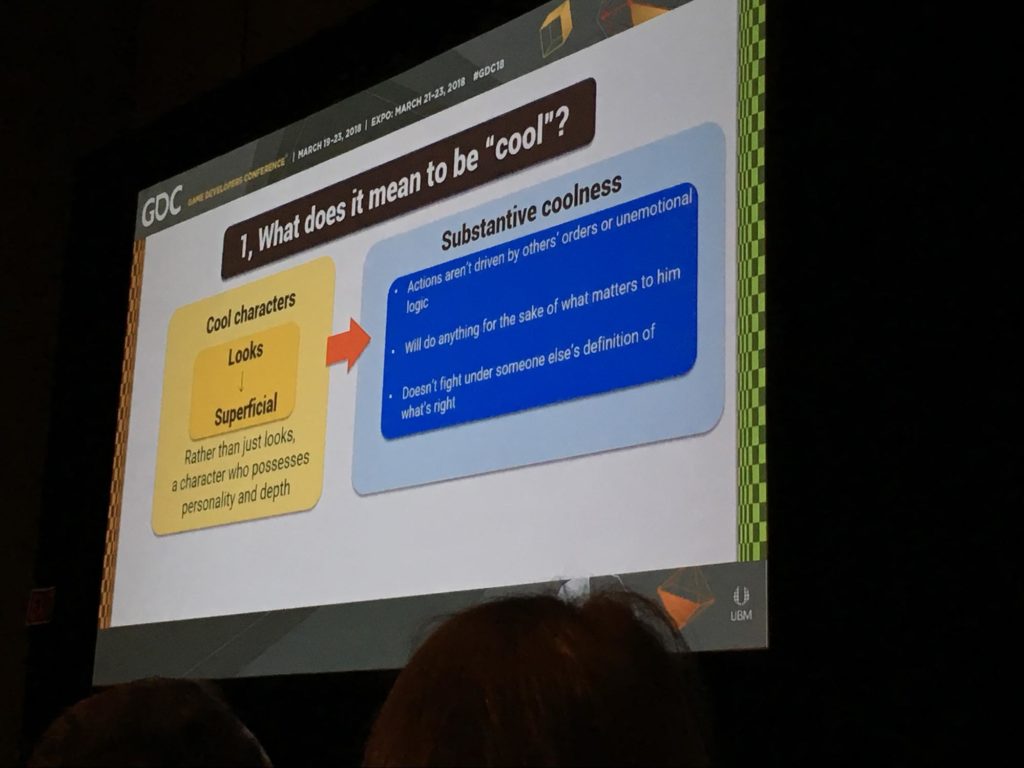
Five Rules
This talk was quite interesting as it featured a series of micro talks by highly reputable game designers in the industry. The talk began on a strong note with the introductory speaker saying:
- Fuck rules or make good ones.
- Use rules to reframe the way you design, use them as a tool.
The next five speakers were equally interesting.
Raph Koster
Raph’s point was start with the sim. He made points about:
- Create an interesting mathematical landscape.
- A simple small set of rules that interlock.
- No implicit goals.
- How do you model this game as math’s.
Erin Hoffman
I’d heard about Erin Hoffman as faculty at the ETC’s SV campus but I had never met Erin before, so it was good to hear from her. Erin talked about:
- Ask yourself the right questions.
- Identify external transformation.
- Design the 5 questions to see if that happened.
- Use effective pre-post test.
Soren
- Know your inheritance (understand what rules you are inheriting).
Josh
- Ask your playtesters why are they doing what they are doing
- Ask them using your systems.
- Allowances for the weird and stupid.
Negatives
- A lot of work, no hero’s journey, scale and scope is a lot, consider.
Stone Lebrande
Stone’s talk I enjoyed very much. He advocated the use of paper prototypes saying ‘Play is on Paper’ and made a number of interesting points including asking a number of important questions about the paper prototype:
- Why? State your intention
- What is the key question you are trying to cover
- Where? Determine the scope
- Single idea
- Session
- Full game (slice of gameplay)
- Meta-Game
- What? State your purpose
- When? Choose the time scale
- Write down your goals of why you are doing the paper prototype
After the talk Stone recommended to checkout his talk about designing games for his kids – 15 years – 15 games.
IGF Design Awards
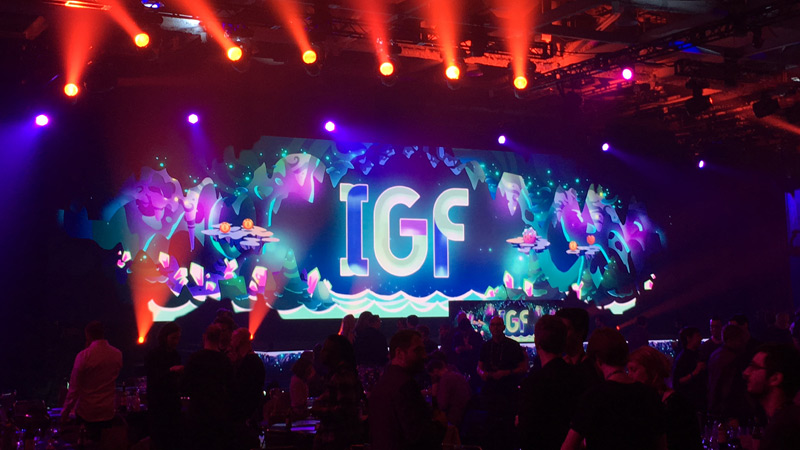
The Award ceremony was entertaining as usual. What was most useful for me was noting several of the ‘Best Design’ and ‘Best Narrative’ games as these are of interest to me:
Design Best
Narrative Best
Day 4 – 3/22/2018
Day 4 was my favorite day of the conference. I went to talks on a number of topics.
Walk Tall, My Friends: Giving Life to AI-Buddies in ‘Final Fantasy XV’
This talk was about creating a good experience with the party in Final Fantasy 15 given by a lead designer at Square Enix. The speaker made a number of interesting points including:
- Can you articulate why players are going to like your game?
- Use stereotypes as a starting point.
- What are your keywords – A gap keywords Otaku/Geek.
- Hierarchy of buddy A.I
- Are they functional?
- Are they believable?
- Are they comfortable?
- Are they emotional?
GDC Microtalks
- Fidelity is not a substitute for aesthetics.
- Allow for ‘speculator’ failure in your decisions.
- Failure is fun too!
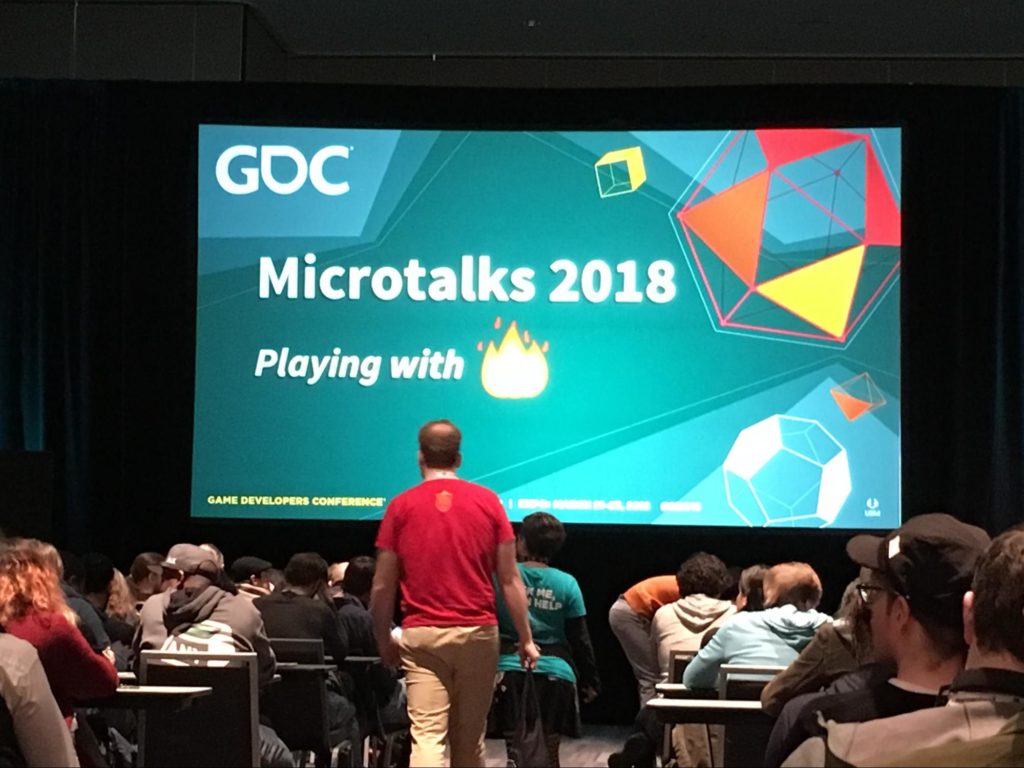
Bob Bates
Bob made a number of interesting points:
- Nurture your inner creativity with new experiences.
- Go out and seek new experiences.
- Don’t snuff at your own creativity.
- Imposter syndrome and self doubt is bad.
‘Friday the 13th’: Design and Balance for Asymmetrical Horror
The talk detailed the design process behind creating the game ‘Friday the 13th’:
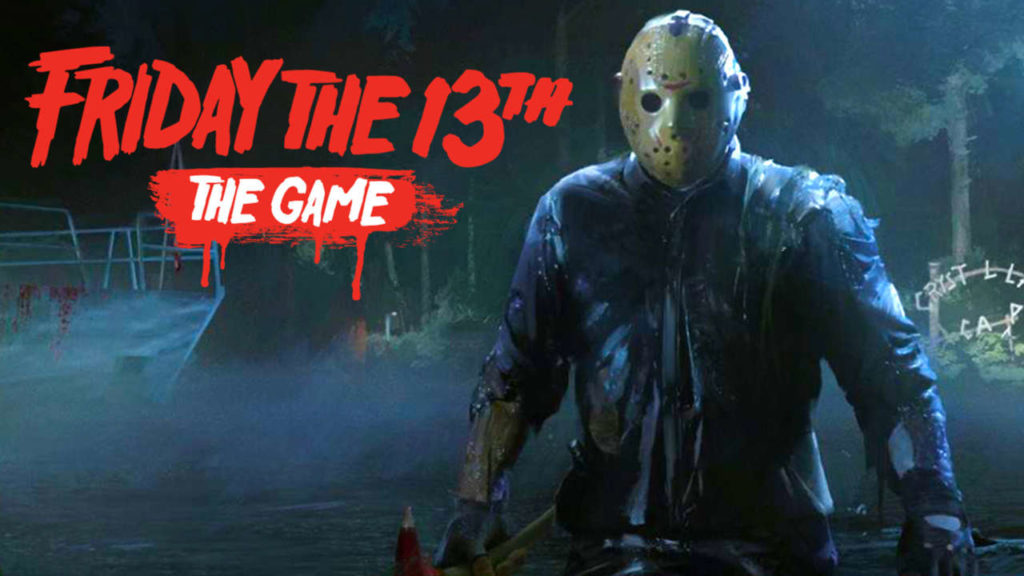
- Define Goals.
- Careful with feedback – can be polluted by whether they won or loss / who they were in the experience.
- Chose design of individual over team – > Backstabbing occurs.
- RNG (Random Number Generator) is a friend, in asymmetric helped with accepting unfairness.
- Proximity based VOIP added some amount of roleplay.
- If you can, use a backend system that holds references and data so changes can be without recompiling.
- Study the IP | Find the fundamentals, Jason’s mask, chase at the end.
Game Mechanics for Storytelling in ‘Monument Valley 2’
This talk detailed how the Monument Valley 2 team went about using game mechanics for storytelling purposes.
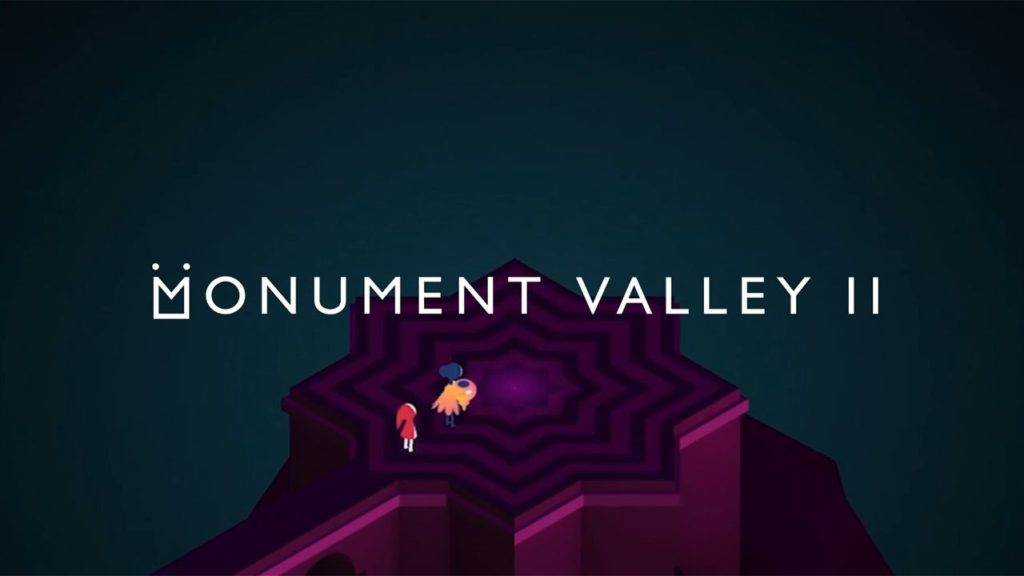
This was a great talk were the speaker made a number of interesting points:
- Game about mother/daughter separation.
- Mechanics used to support game.
- Difficulty adjusted as per message.
- Level design tried to reflect message:
- Mother levels going inward to express how she is turning inwards.
- Daughter levels going upwards to express how she is emotionally reaching out.
- Impossible geometry possible through perspective.
Helping Players Hate (or Love) Their Nemesis
Probably my favorite talk of the conference. This talk was on how the game Shadow of War went about creating a relationship with the player using the nemesis system. Points made included:
- Maximize the hate
- Maximize the length of the arcs story
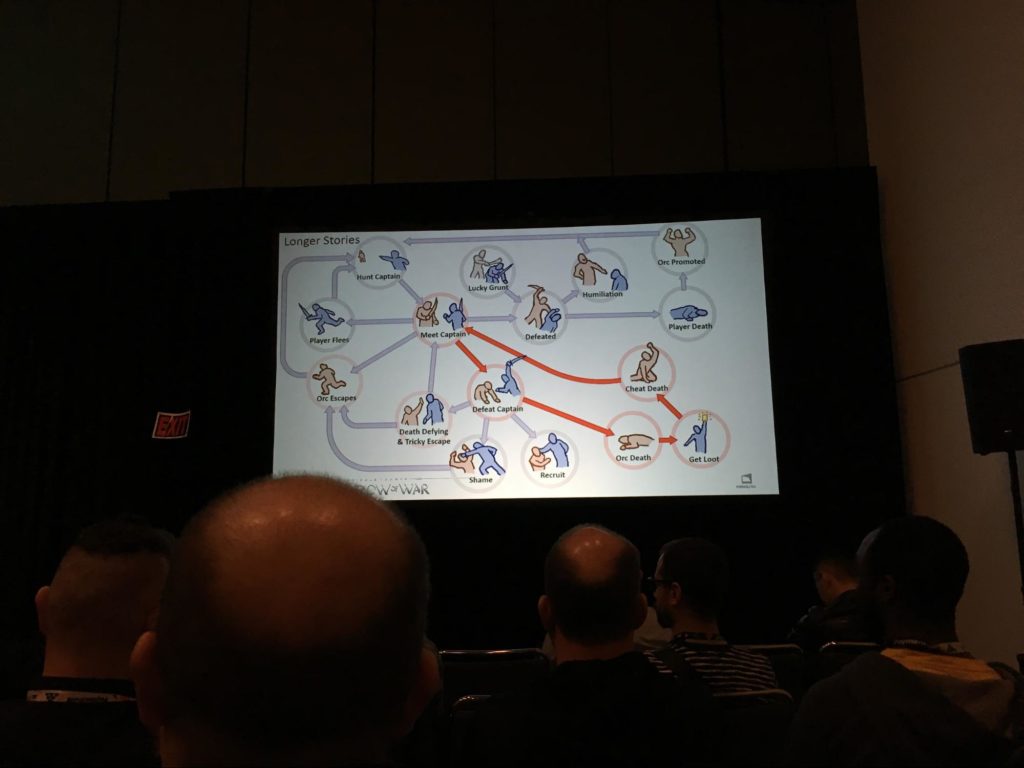
- We don’t know who your nemesis will be.
- Maximize correlations supporting their identity.
- Scope and nature of design should be unclear to players.
- Talking points:
- Uniqueness and novelty.
- Emotional investment.
- Competence and mastery.
- Embrace exceptions in the design
- Exceptions -> Remembering -> Relationship -> Emotion
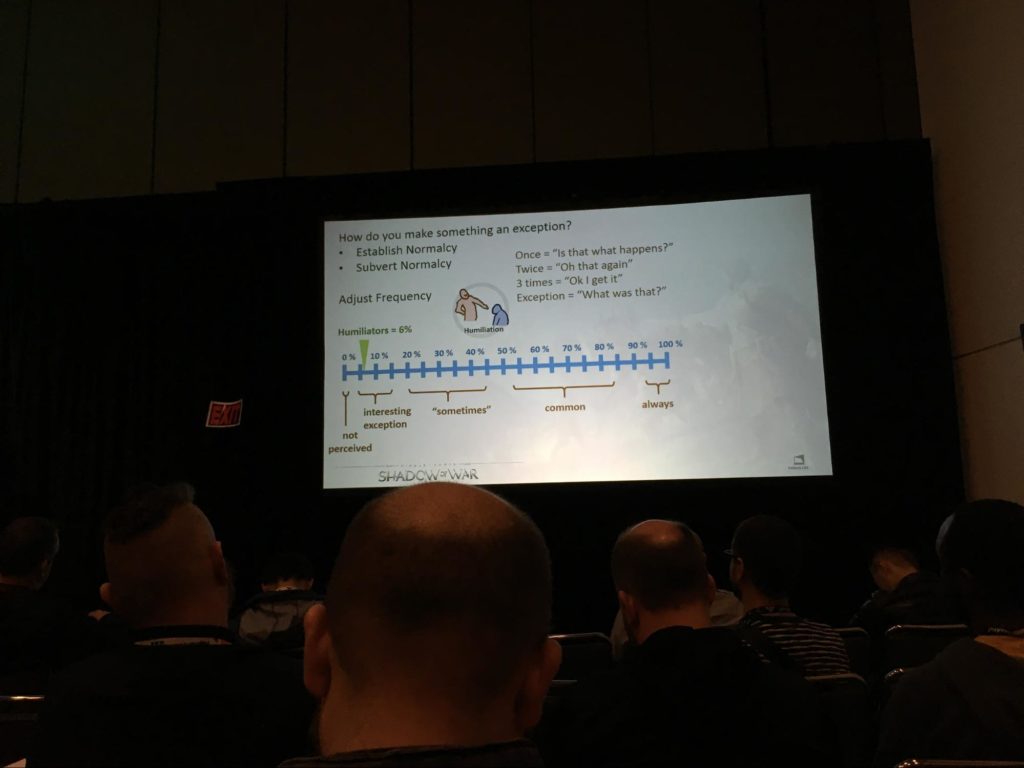
- Love is similar to hate

Horizon Zero Dawn Post Mortem
This talk went into detail about the production process behind Horizon Zero Dawn.
- Started with high level questioning.
- Created prototypes to answer those questions
- Make a prototype to connect these prototypes [Find out what your game is not].
- After proof of concept started pre-production.
- Narrative team did good stuff.
- They introduced context (careful with context).
Production
- Problem 1 – Balancing systems was hard
- Problem 2 – Robot Combat
- Problem 3 – Humanoid Combat – > Focus on encounter design
Polish
- Long term testing showed meta issues.
- Economy issues showed.
Good Rules of thumb
- Review often.
- Be honest and flexible.
- Adapt if necessary.
Day 5 – 3/23/2018
With the conclusion of the conference I spent most of my time visiting the expo floor. The one talk I did go to was given by Schell Games’s Shawn Patton.
Playtesting VR Brownboxing, Spy Cams & Fuzzy Rugs
- Playtesting: Avoid Evil Data (useful talk).
- Large range of devices make VR adaptive slower.
- Playtest note:
- End time/total time.
- Bug severity.
- Name/Start time.
- Good related notes/unexpected actions.
- Check point timesteps.
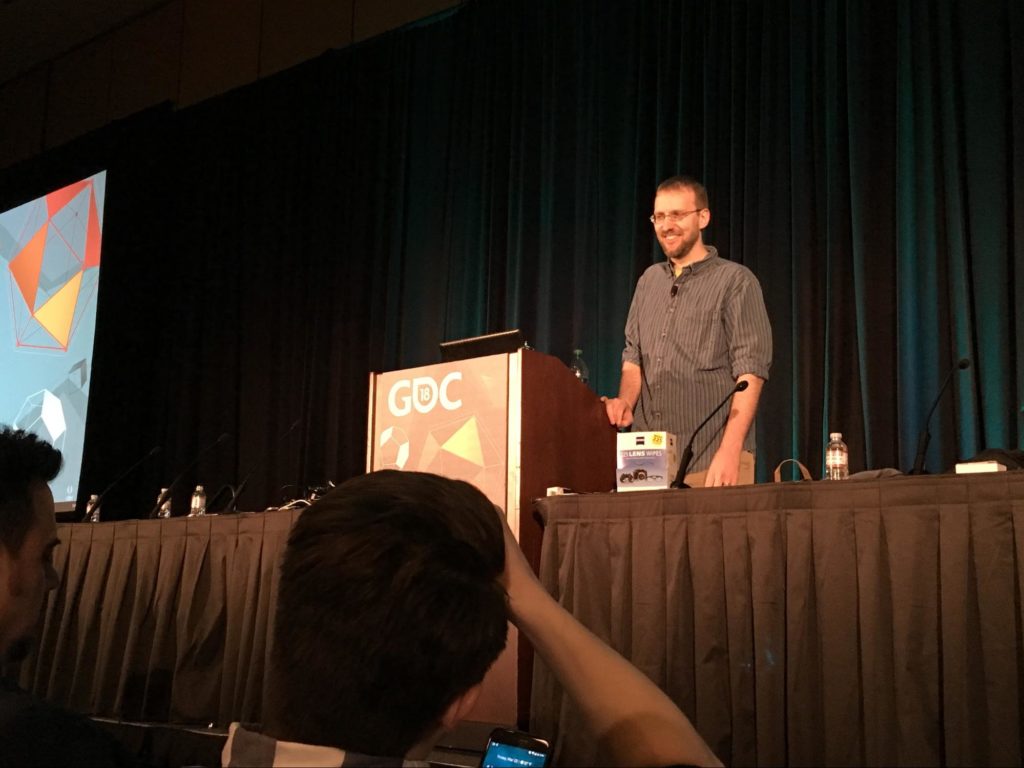
- Good questions to ask:
- What was the most frustrating moment or interaction?
- What was your favorite moment or interaction?
- Was there anything you wanted to do but couldn’t?
- If you had a magic wand to wave and you could change, add or remove anything from the experience, what would it be?
- (New) When did you feel most clever?
- How would you describe the experience to your friends?
Shawn mentioned a useful mnemonic for a number of these questions:
- FFWW – Frustrated, Favorite, Want, Wand.
Tips of What Not to Do
- Don’t use superglue near optics.
- Don’t talk while your player is playing.
Main Recap
- VR is still new.
- Playtesting is critical.
- Ask and track the right questions.
- Take care of your guest.